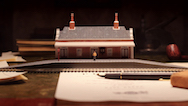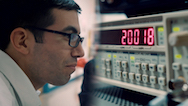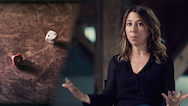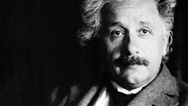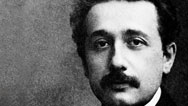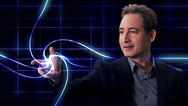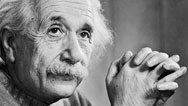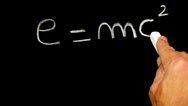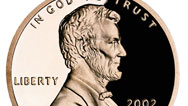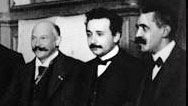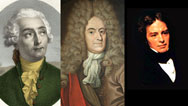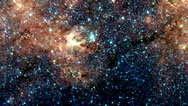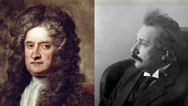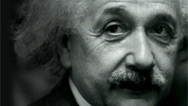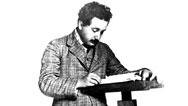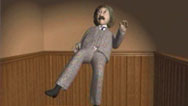
Inside Einstein's Mind
Retrace the thought experiments that inspired his theory on the nature of reality. Airing May 30, 2018 at 10 pm on PBS Airing May 30, 2018 at 10 pm on PBS
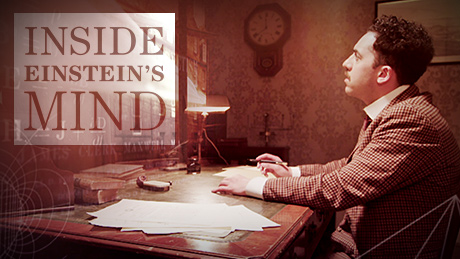
Program Description
Transcript
Inside Einstein's Mind
PBS Airdate: November 25, 2015
NARRATOR: It's a mysterious force that shapes our universe. It feels familiar, but it's far stranger than anyone ever imagined. And yet, one man's brilliant mind tamed it: gravity. Using simple thought experiments, Albert Einstein made an astonishing discovery: time and space are shaped by matter.
CLIFFORD JOHNSON (University of Southern California): You get rid of this force of gravity, and, instead, we have curvature of space-time.
JANNA LEVIN (Columbia University): Right now, the space around me is being squeezed and stretched.
NARRATOR: He called it the "General Theory of Relativity." How did one person, working almost entirely alone, change everything we thought we knew about the universe?
DAVID KAISER (Massachusetts Institute of Technology): Einstein is toiling as the world seems to fall apart.
ROBBERT DIJKGRAAF (Institute for Advanced Study): He was able, with pure thought, to solve the riddle of the Universe.
NARRATOR: Inside Einstein's Mind, right now, on NOVA.
Gravity: the most familiar yet most mysterious of nature's forces. One hundred years ago, Albert Einstein made a mind-blowing discovery: what we feel as gravity is, in fact, the push and pull of space and time, itself. He called his idea "general relativity." It is perhaps the most remarkable feat of thinking about nature to come from a single mind.
CLIFFORD JOHNSON: General relativity is undoubtedly one of the greatest scientific theories ever conceived. It's a theory of space, time and gravity.
JANNA LEVIN: One mathematical sentence, and from it, you can derive the understanding of the entire universe on the largest scale, and that is beautiful.
NARRATOR: Only now, a century after it was first proposed, do we have the technology to explore the extremes of Einstein's great theory: supermassive black holes at the center of galaxies, waves of gravity that distort space and time, the evolution of our entire universe.
How did a concept that explains so much come from the mind of one man?
JOHN NORTON (University of Pittsburgh): Einstein had a magical talent. He could take a hard physical problem and boil it down to a powerful visual image, a thought experiment.
SEAN CARROLL (California Institute of Technology): Suddenly, he realizes this is how the world works; all this abstract nonsense is the correct theory of reality.
NARRATOR: To gain an insight into Einstein's mind and the true wonder of general relativity, we need to trace the crucial thought experiments that led to his great breakthrough. The seeds for his ideas were planted when he was just a child.
Einstein grew up in a small house in Munich, in Southern Germany. His unique personality was evident early on.
WALTER ISAACSON (Biographer): Like many great innovators, Einstein was a rebel, a loner, but deeply curious. He was slow in learning to speak as a child, so slow that his parents consulted a doctor, but he later said that that's maybe why he thought in visual thought experiments. His sister remembers him building little card towers, using playing cards. He was a daydreamer, but he was deeply persistent.
NARRATOR: Einstein's father, Hermann, manufactured electrical equipment. He nurtured his son's interest in science. On one occasion he brought him a compass.
WALTER ISAACSON: Now, you and I maybe remember getting a compass when we were kids, and we're like, "Oh, look, the needle twitches and points north." But, you know, then we're on to something else, like, "Oh, look, there's a dead squirrel." But for Einstein, after getting that compass, he developed a lifelong devotion to understanding how things can be forced to move even though nothing's touching them.
NARRATOR: The young Einstein became gripped by a desire to understand the underlying laws of nature. He developed a unique way of thinking about the physical world, inspired by his favorite book.
WALTER ISAACSON: The book Einstein loved told little stories, like what'd be like to travel through space or go through an electrical wire, and it made Einstein think visually.
NARRATOR: These imagined situations that we often call "thought experiments," became a defining feature of Einstein's thinking.
DAVID KAISER: One of the critical thought experiments that Einstein began to play with, very young, around the age of 16, was trying to imagine what would happen if he could catch up with a light wave. It's one thing to see, to imagine a light wave zooming past him, at some seemingly impossible speed, but what if he could somehow just propel himself, really quickly. What would it look like if he could catch up with that light wave? What would he see?
WALTER ISAACSON: He said it caused him to walk around in such anxiety his palms would sweat. Now, you and I may remember what was causing our palms to sweat at age 16, and it was not a light beam. But that's why he's Einstein.
NARRATOR: This dream-like thought about the nature of light was Einstein's first step on the path to his great theory. It stayed with him, throughout his time at school and college.
DAVID KAISER: He was extremely gifted in science and math, as a young person, and very bad at other classes, mostly cause he kept cutting class and being very rude to his teachers. Many teachers from when...his high school days on, were convinced he'd never amount to anything. He was a discipline problem, and he was bad news.
WALTER ISAACSON: He applies to the second best university in Zurich, the Zurich Polytech, and gets rejected,—I'd love to meet the Admissions Director who rejected Albert Einstein—but eventually he gets in. And he does moderately well, but not good enough to get a teaching fellowship. And so he ends up at the Bern Swiss Patent Office, as a third class examiner.
NARRATOR: Undaunted by his university results, Einstein started work at the patent office in 1902, aged 23. Here, his job was to assess the originality of new devices.
DAVID KAISER: He was immersed in the kinds of, of, sort of, technical details that he'd been fascinated by as a very young kid. And here he was, sitting in the kind of wave of, of, of the modern age. This was the era of electrification, so all the latest clever ideas for switching technology, for coordinating clocks, in particular, those were all passing through his office.
NARRATOR: Time zones had recently been introduced in central Europe, and accurately synchronizing clocks was a major challenge of the day. Switzerland was a world leader in time technology. Dozens of patents to link clocks passed through Einstein's office.
WALTER ISAACSON: He could whip through these patent applications, and then, out of his drawer, he'd pull his physics notes. And his boss was very indulgent and would, sort of, turn a blind eye, as Einstein was doing his theories in his spare time.
SIMON SCHAFFER (University of Cambridge): It's really important to remember that theoretical physics was new when Einstein was a young man. You could do quite a lot of this work by reading a relatively small number of science journals and making the calculations yourself.
Einstein's world, in 1905, was dominated by two kinds of physics. One was about 200 years old, and it was founded by Isaac Newton, a British natural philosopher. For Newton, all there is in the world is matter, moving.
NARRATOR: Newton showed that the motion of falling apples and orbiting planets are governed by the same force: gravity. His equations are so effective, we still use them today to send probes to the farthest reaches of the solar system.
The other important theory of Einstein's day covered electricity and magnetism. That branch of physics had been revolutionized, in 1865, by the Scottish physicist James Clerk Maxwell. Maxwell's theory describes light as an electromagnetic wave that travels at a fixed speed. In Newton's world, the speed of light is not fixed.
SIMON SCHAFFER: Einstein can see that there's a contradiction between Newton and Maxwell. They just don't fit together. And one of the things Einstein hated, hated was contradiction. If there's one kind of physics that says this and another kind of physics that says that and they're different, that's a sign that something's gone wrong, and it needs fixing.
NARRATOR: For months, Einstein wrestles with the problem. Eventually, to resolve this contradiction, he focuses on a key element of speed: time.
WALTER ISAACSON: He realized that any statement about time is simply a question about what is simultaneous. For example, if you say the train arrives at seven, that simply means that it gets to the platform simultaneous with the clock going to seven.
NARRATOR: In a brilliant thought experiment, he questions what "simultaneous" actually means and sees that the flow of time is different for an observer that is moving, versus one that's standing still.
He imagines a man standing on railway platform. Two bolts of lightning strike on either side of him. The man is standing exactly halfway between them, and the light from each strike reaches his eyes at exactly the same moment. For him the two strikes are simultaneous. Then Einstein imagines a woman on a fast moving train. Travelling at close to the speed of light, what would she see?
As the light travels out from the strikes, the train is moving towards one and away from the other. Light from the front strike reaches her eyes first. For the woman on the train, time elapses between the two strikes; for the man on the platform, there is no time between the strikes.
This simple thought has mind-blowing significance. Simultaneity, and the flow of time itself, depends on how you're moving.
SEAN CARROLL: If there's no such thing as simultaneity, then there's no such thing as absolute time everywhere, throughout the universe, and Isaac Newton was wrong.
NARRATOR: This concept, that time, and space, as well, are relative, became known as "special relativity." It led to remarkable results, such as the famous equation relating energy to mass.
DAVID KAISER: So, Einstein published this article in 1905, to exactly no acclaim. Most people ignored it. This was not setting the world on fire. Two years go by before a very eminent physicist, Johannes Stark, invites Einstein to write a review article on Einstein's own work, precisely because no one was paying attention. He begins thinking about ways to generalize and to push his own results from 1905. What if he considers not only a train moving at a fixed speed past the platform, what if that train begins to speed up or slow down? What if there's acceleration?
NARRATOR: Adding acceleration to the equations was his first task. Then, there was that mysterious Newtonian force of gravity to contend with.
In Newton's theory, gravity is a force that acts instantaneously, but special relativity says that's impossible; nothing can travel faster than light.
ELEANOR KNOX (King's College London): What Newton's theory tells you is that, suppose the sun were to disappear, the orbit of the earth should change "at that very moment." But the notion of "at that very moment" in two different places is exactly one of these notions that special relativity has told you isn't a good physics notion. So, you've now got this challenge of trying to work out how to take the success of Newton's theory of gravity but fit into this new special relativistic picture.
NARRATOR: It was only when Einstein began to understand the link between gravity and acceleration that things began to fall into place.
ROBBERT DIJKGRAAF: We all know that when we are accelerated—and, of course, now we have cars and airplanes to give us the physical feeling—if you're in an airplane, and it's taking off, you're pushed back in your chair, actually a kind of force pushing you back, which feels very similar to the force of gravity. But you need the brilliance of Einstein to explain why they are related.
NARRATOR: Suddenly he hits upon what he describes as "the happiest thought" of his life. If gravity and acceleration feel the same, perhaps they are the same. Again, he examines the idea in a beautiful thought experiment.
He imagines a man in a box, floating weightlessly in a distant region of space, in zero gravity. Suddenly, the man stops floating and accelerates downward until he's standing in the box. What has happened? Either the box is now close to a planet, and the force of gravity has pulled the man to the floor, or someone has attached a rope and the box is now being pulled continuously and accelerated upwards. So which is it, gravity or acceleration?
Without being able to see outside, the man can't tell what's causing his fall to the floor.
SEAN CARROLL: Einstein realized there is no way to tell the difference between sitting in a gravitational field and being accelerated. They're equivalent situations.
CLIFFORD JOHNSON: The fact that these two effects are the same, give the same result, means that gravity is acceleration, not just like acceleration; it's the same thing.
NARRATOR: It's a big breakthrough. Einstein's theory of special relativity worked for motion at a constant speed. By extending his ideas to acceleration he could begin to formulate a new theory of gravity.
By 1912, Einstein is living in Zurich with his wife Mileva and two young sons Hans and Eduard. The academic world had realized the importance of special relativity and his career had taken off. He's now a professor at the esteemed Swiss Federal Institute of Technology, but spends as much time as possible working on his theory.
He needs mathematics that describes how objects move in space and time and soon realizes that the best tool for the job is a strange but powerful concept called "space-time."
JANNA LEVIN: If I think of space, I know that I can find anything, if I know where it is North-South, East-West and up-down, three points. But that doesn't mean I can find it, because I also have to know where it is in time. And so, if we start to think, to know everything about an event in the universe, I have to know, not just its spatial coordinates, but also its time coordinate. I can begin to think about where it is in space-time.
NARRATOR: Imagine a camera filming an action, capturing each moment in time as a single frame.
ROBBERT DIJKGRAAF: Einstein basically tells us, think of a movie reel: we have all these little pictures. Now, cut them apart, one by one, and stack them on top of each other. You get this pile. And if you go up in the pile, you go up in time. And now, kind of glue them all together into one big block, and that block has both space and time, and that's the space-time continuum.
It's almost looking at a movie, not frame by frame, but seeing the whole movie at once. There would now be kind of, two strands going up in space and time, and they would be, kind of, spaghetti strands. In fact, we all are spaghetti strands moving in this space-time.
NARRATOR: Einstein feels that space-time is the natural arena in which his theory of relativity should play out, but now he needs sophisticated mathematics.
SEAN CARROLL: By your standard or mine, Einstein was good at math. He was Einstein. But he was not really a mathematician, per se. He didn't prove theorems; he didn't pore over math books. He was a physicist. He did thought experiments. He thought of very tangible concrete situations and what would happen. So, when it came time for him to really bear down to the absolute cutting edge mathematics of his day, he required help.
NARRATOR: At university, Einstein had skipped the geometry classes, letting his friend Marcel Grossman take notes for him. Grossman had excelled in geometry and was now chairman of the math department. He suggests Einstein uses advanced mathematics, in which the shape of space and time could be curved.
SEAN CARROLL: Because space-time has a geometry, he thinks to himself, well, maybe it's the actual shape of space-time itself that is giving rise to gravity.
NARRATOR: After months of work, Einstein has an extraordinary idea: what if space-time is shaped by matter, and that's what we feel as gravity?
CLIFFORD JOHNSON: In struggling to figure out what causes gravity then, Einstein has this great insight. It is simply that a mass distorts the shape of space-time around it, so, you get rid of this force of gravity and, instead, we have curvature of space-time.
SEAN CARROLL: In Einstein's universe then, if space were empty, it would be flat. There'd be nothing going on. But as soon as you put objects down they warp the space and time around them, and that causes a deviation of the geometry, so that now things start moving.
ROBBERT DIJKGRAAF: Everything wants to move as simple as possible through space and time. But Einstein tells us that mass sculpts space and time, it's the curved motion through this sculpture that's the force of gravity.
ELEANOR KNOX: We have this feeling that the reason I can feel pressure on the soles of my feet, that the reason things are going to drop when I throw them, are because there's a force attracting us down to the center of the earth. What general relativity tells you is that's not the right way to think about what's going on there. What's really going on is that your natural path in space-time would take you to the center of the earth. And what's actually happening is the floor is getting in the way, it's pushing you upwards.
SEAN CARROLL: When we look at it, we go, "Ah, the force of gravity." But Einstein says, "No, no, no: the curvature of space-time."
NARRATOR: It's a stunning insight. Just as ant might feel forces pulling it left and right as it walks over crumpled paper, when, in fact, it's simply the shape of a surface dictating its path, Einstein saw that what we feel as the force of gravity is, in fact, the shape of the space-time we're moving through.
Einstein now has everything he needs to formulate his final theory of gravity, but he makes a critical mistake. He misinterprets one of his equations and, unaware of his error, continues working on incorrect ideas.
JOHN NORTON: The point at which Einstein is going to give the most essential equations of the theory, Einstein considers something like them, and then says, "Ah, but these don't work," and then writes down the wrong equations. What follows are alternations of confidence and despair, as he convinces himself that everything was fine with this theory, and then he realizes that things aren't so good with the theory.
It is a long, dark period for Einstein, as he struggles to reconcile himself with a theory that is just not working.
NARRATOR: Two years later, Einstein is in Berlin. At just 36 years old, he has one of the most prestigious positions in physics. But he is still struggling with his theory.
WALTER ISAACSON: By 1915, he'd reached the pinnacle of the profession. He's in the Prussian Academy and a professor at the University of Berlin. But his marriage is falling apart, his wife and his two kids have moved back to Switzerland. So he's pacing around almost all alone, in this apartment, in Berlin.
NARRATOR: And now, he has a competitor. Einstein had enthusiastically shared his ideas with the brilliant mathematician David Hilbert. Hilbert was so impressed, he decided to work on the theory, himself. Einstein is now in a race to the finish, with one of the world's best mathematicians.
DAVID KAISER: This is unfolding in a remarkably dramatic period in history. World War I has begun to ravage central Europe. Einstein is not just toiling in the abstract, he's toiling as the world seems to fall apart.
NARRATOR: By November, 1915, Einstein is scheduled to present his work in a series of four weekly lectures at the esteemed Prussian Academy. But he's struggling to formulate his ideas.
In the midst of these challenges, letters arrived from his wife in Zurich pressing the issue of his financial obligations to his family and discussing contact with his sons.
As his lectures begin, his theory is still far from complete. The pressure on Einstein is huge.
SIMON SCHAFFER: He would give a lecture, revise it, give it again, spot mistakes, correct them, get up on the podium, explain what was wrong in the previous week's lecture, correct it and then move on, and then do that again and again, for four weeks running. His work to convince them of the truth of this absolutely radical new theory of relativity that he was proposing, is one of the most intense periods of work in the history of science.
NARRATOR: Somehow he's able to focus on his theory with an incredible intensity, and he makes his breakthrough.
He tests his equations on a problem that Newton's theory of gravity couldn't solve: the orbit of Mercury. Mercury's path around the sun has an anomaly that Newton's theory can't explain: it deviates slightly each time it goes around. Einstein calculates the orbit with his new equations. The answer is correct, exactly what astronomers had observed.
He'd found the final equations for his general theory of relativity.
SEAN CARROLL: You have to think about the hubris of being Albert Einstein. He had already thrown out Newtonian mechanics with special relativity. And then he had gone off on his little personal quest to incorporate gravity. And at the end of the day, he boils it down to a prediction for a number that had been observed, the procession of the orbit of Mercury. And, miraculously, when the pages of algebra work out to their end, you get the right answer. And, suddenly, it's not just playing with equations anymore. He realizes this is how the world works; all this abstract nonsense is the correct theory of reality.
SIMON SCHAFFER: Einstein is, at last, able to present a successful theory. That's a triumphant moment, one of the great moments in the history of physics, and for Einstein, a victory very much against the odds. And he'd won.
NARRATOR: On the 25th of November, 1915, Einstein lays out his findings in his climactic fourth lecture at the Prussian Academy. He presents general relativity. The theory can be written as a single equation. It condenses sprawling complexities into a beautifully compact set of symbols…
ROBBERT DIJKGRAAF: So the formula is really simple: G-m-u equals…
NARRATOR: …G for the shape of space-time and T for the distribution of mass and energy.
ROBBERT DIJKGRAAF: So this very simple formula captures all of Einstein's general relativity. It's a beautiful, simple equation, but it's a lot of work to unpack the symbols, the mathematical symbols and see how, in this very simple formula, the whole geometry of the universe is hidden. It's, kind of, an acquired taste to see the beauty.
It's also a signature formula for Einstein. The true mark of his genius is that he combines two elements that actually live in different universes. The left-hand side lives in the world of geometry, of mathematics; the right-hand side lives in the world of physics, of matter and movement. And so, perhaps, the most powerful ingredient of the equation is this very symbol—equal sign here—these two lines that are connecting the two worlds. And it's quite appropriate the two lines, because it's two-way traffic.
Matter tells space and time to curve, space and time tells matter to move.
NARRATOR: When Einstein presented his great theory, few people understood it. He needed a way to prove to the world that the counterintuitive features of his theory were real.
SIMON SCHAFFER: The general theory of relativity made predictions of things which looked really strange, for example, the idea that light bends when it passes near a very heavy body. No one had ever looked for that. No one had ever observed it. Einstein was desperate, desperate to get astronomers to make that test.
NARRATOR: Einstein's theory predicts that when light from a distant star travels close to the sun, the warped space around the sun bends the light's path.
In May, 1919, the English astronomer Arthur Eddington traveled to the African island of Principe to record images that would show this phenomenon.
DAVID KAISER: What Eddington was able to do was take photographs of stars during a total eclipse of the sun, so that the moon blocked most of the brightness of the sun and little pin pricks of light could be seen around the sun. Otherwise, it would be lost in the glare. And Eddington and his colleagues were able to measure that the appearance of those stars had been shifted, compared to where they would have been had that big mass of the sun not been deflecting that light from far away.
SIMON SCHAFFER: He's able to show that Einstein's general relativity theory is right, and a revolution in science has been accomplished.
WALTER ISAACSON: When the eclipse experiments prove Einstein's theory right, he rockets to fame. Not just because he's explained a new way of looking at the universe, but at the end of World War I, you had the predictions of a German scientist be proven right by some British astronomers. And it becomes headlines across the world. New York Times says, "Lights all askew at the heavens, men of science more or less agog."—This is back when newspapers knew how to write great headlines.—But Einstein, kind of, loves this fact that he's now an icon of science.
NARRATOR: Einstein becomes a worldwide celebrity, the icon of genius we still recognize today.
SIMON SCHAFFER: The only person who was more widely known was Charlie Chaplin, and they got on like a house on fire. Chaplin said, "The reason they all love me is because they understand everything I do, and the reason they love you is that they don't understand anything you do. Can you explain that?" And Einstein said...
NARRATOR: But in 1930s Berlin, the Nazi party is gaining power. As a Jewish scientist, Einstein becomes increasingly caught up in the political turmoil.
DAVID KAISER: Einstein's theories became a target. They were deemed aesthetically repugnant to a, kind of, an Aryan sensibility. So people attacked not just Einstein the Jewish scientist, they would actually have people denouncing general relativity.
NEWSREEL: In January, Nobel-prized mathematician Albert Einstein visited California.
NARRATOR: He begins to make trips to America, where he is welcomed with open arms. And in 1933, he settles in Princeton, with his second wife Elsa, taking up a position at the Institute for Advanced Study.
Today, the Institute is headed by Professor Robbert Dijkgraaf.
ROBBERT DIJKGRAAF: He, basically, was still very much by himself, just, actually, as he was in Berlin, just concentrating on his deep ideas and struggling with understanding the universe. Of course, his office was here.
NARRATOR: At the Institute, Einstein worked to unify his theory of gravity with the other laws of physics.
ROBBERT DIJKGRAAF: With Einstein, you see this phenomena you see with many great scientists, that they climb this very high mountain and instead of celebrating their success, they're privileged to see a much wider landscape, and they see all these mountains behind it. And I think he was very much aware how much still there was to be done.
'Til the very last days of his life, he was trying to push these equations and find a description of nature, all of nature, in terms of the geometry of space and time.
NARRATOR: But general relativity was fading from mainstream science. Physics was now focused on the quantum theory of atoms and tiny particles, a theory incompatible with Einstein's ideas, but one that could be tested in the lab. Most of general relativity was then beyond the reach of experiment.
When Einstein died, in 1955, aged 76, his theory was seen as one with little hope of future discovery.
SEAN CARROLL: The best theories in physics always take us to places where the people who invented them didn't imagine. And a truly wonderful theory, like general relativity, predicts all sorts of things that Einstein didn't conceive of. The theory has a life of its own. We understand general relativity much better, right now, than Albert Einstein ever did.
NASA MISSION CONTROL/FILE FOOTAGE: Liftoff of space shuttle Discovery, with the Hubble Space Telescope, our window on the universe.
NARRATOR: Today, 100 years after general relativity was first presented, new technology is allowing us to explore the most remarkable predictions of the theory: an expanding universe; black holes; ripples in space-time; and perhaps the most bizarre, the idea that not just space, but time, itself, is distorted by heavy objects.
NARRATOR: To prove it, a team of physicists is carrying out a remarkable experiment. They're using two atomic clocks that are in near perfect sync, accurate to a billionth of a second. The master clock remains at sea level while they take the second clock to the top of New Hampshire's Mount Sunapee.
General relativity tells us that as you move away from the mass of the planet, time should speed up. After four days at the top of the mountain, the test clock is taken back to the lab for comparison. There, they compare it to the sea level master clock. Four days ago they were in ticking in unison. But what about now?
DAVID SCHERER (Microsemi Corporation): You guys ready? This is it, right here. The time interval counter is going to show us the time difference between these two clock ticks.
Twenty nanoseconds!
You can see the time difference between them represented here, graphically: the clock that was up at the mountain for four days and our master clock.
NARRATOR: Gravity, the distortion of space and time, becomes weaker as you move away from the surface of the planet, so while the test clock was up the mountain, time sped up. It's now 20 nanoseconds, 20 billionths of a second, ahead of the sea level clock.
DAVID SCHERER: This is awesome.
NARRATOR: This distortion of time has surprising consequences. The Global Positioning System, something we all take for granted, wouldn't work without taking this into account. The engineers who built the G.P.S. system we use every day to pinpoint locations, had to ensure it adjusted for the time difference between clocks on satellites and receivers on the ground. If they didn't, G.P.S. would be off by six miles every day.
JIM GATES (University of Maryland): Your G.P.S. units use the results of general relativity. When you navigate in your car, you perhaps should give a word of thanks to Uncle Albert.
NARRATOR: Of all general relativity's predictions that new technology has allowed us to explore, there's one that's straight out of science fiction: a black hole.
KIP THORNE (California Institute of Technology): Everything that we are familiar with in ordinary life is made from matter, but not black holes. Black holes are made from warped space and time and nothing else. A black hole is an object that is spherical, like a star or like the earth, with a sharp boundary, called the horizon, through which nothing can come out. So, it casts a shadow on whatever is behind it. It's just a black, black shadow, unbelievably black.
NARRATOR: This simulation shows the distortion of starlight around a black hole. Even though Einstein knew his theory predicted black holes, he found it hard to believe they would really exist in nature.
In the 1960s, Professor Kip Thorne worked on the mathematical concept of black holes. The idea made sense on paper and he began to feel that these science-fiction-like objects might actually be real.
KIP THORNE: Must be here somewhere. It's in one of these piles.
NARRATOR: Kip Thorne made a bet with fellow physicist Stephen Hawking about whether or not a strong source of x-rays, known as Cygnus X-1, was in fact a black hole.
KIP THORNE: I think it's in here, yeah, here we go: relativity, stars and black holes. Yeah, here it is. So, that is a copy of the famous bet: "Stephen Hawking bets one-year subscription to Penthouse magazine as against Kip Thorne's wager of a four-year subscription to a political magazine called Private Eye, that Cygnus X-1 does not contain a black hole of mass above the Chandrasekhar limit. It's witnessed this 10th day of December 1974."
Stephen Hawking had a terribly deep investment in it actually being a black hole, and so he made the bet against himself as an insurance policy, so at least he would get something out of it, if Cygnus X-1 turned out not to be a black hole.
The evidence mounted, thereafter, over the period of the70s and 80s, and in June, 1990, Stephen snuck into my office and signed off on the bet, that, finally, the evidence was absolutely overwhelming that Cygnus X-1 really is a black hole.
And eh, Penthouse magazine arrived. He sent me the British version of Penthouse, which was ever so much more raunchy than the American Penthouse, actually, enough to make my face turn red, when I received it, at first.
NARRATOR: Today, we have evidence suggesting that there are millions of black holes in our own galaxy alone. But perhaps the most profound prediction of general relativity is that our universe had a hot dense beginning that we call the "Big Bang."
The discovery that distant galaxies are moving away from us and that there's a background radiation permeating space, provided evidence for the Big Bang and a universe that's growing.
SAUL PERLMUTTER (University of California, Berkeley): With this picture of an expanding universe, there were natural questions: Is the universe slowing down as it expands? Is it so dense that someday it will come to a halt and collapse? Will the universe come to an end? These seemed like good questions.
NARRATOR: To find answers, in the 1990s, Saul Perlmutter and his team observed exploding stars, called "supernovae," to track the growth of the universe.
SAUL PERLMUTTER: When we made the measurement, we discovered that the universe is not slowing down enough to come to a halt; in fact, it's not slowing at all, it's speeding up! The universe is expanding faster and faster.
NARRATOR: But what's pushing it?
SAUL PERLMUTTER: In order to explain the acceleration of the universe within Einstein's theory of general relativity, we're considering an energy spread throughout all of space that we've never seen before. We don't know what it is. We call it dark energy. And if so, it would require something like 70 percent of all of the stuff of the universe to be in this form of previously unknown dark energy.
So, this is a lot to swallow, and you might imagine, at that point, you should go back and revisit your theory. The problem is that Einstein's theory is so elegant, and it predicts so many, many, many digits of precision, that it's very, very difficult to come up with any other theory.
NARRATOR: There is one final prediction of general relativity that remains untested: gravitational waves.
JANNA LEVIN: There are huge things in the universe happening, like black holes colliding or stars exploding, and they create these gravitational waves, waves in the shape of space and time that travel through the universe at the speed of light. And so, right now, the space around me is being squeezed and stretched by gravitational waves just getting here from, let's say, two black holes colliding a billion light years away. But the squeezing and stretching is so minute, I absolutely could not, personally, detect it. And so, what we're trying to do is build an instrument that can.
NARRATOR: In Louisiana and Washington State, a vast experiment called LIGO is in the final phases of calibration. It's hoped that laser beams, traveling two and a half miles between precisely aligned mirrors, will measure the squeezing of space caused by gravitational waves. This could open up an entirely new window on the universe.
For 100 years, general relativity has been proven to be correct time and time again, but Einstein himself knew that his great theory had limits. It remains incompatible with the quantum world of tiny atomic particles.
Here, at the Institute for Advanced study, where Einstein worked, the world's leading theoretical physicists are trying to solve the problem Einstein never could, finding a single set of rules that applies to both the cosmic and atomic scales, a unified theory, the Holy Grail of physics.
ROBBERT DIJKGRAAF: We are now in what, at this time, is the School of Physics. Here, people are still struggling with many of the same issues that Einstein struggled with, trying to capture the laws of the universe from the very small to the very large in a single equation. And it's still blackboards that are the weapons of choice.
The brightest minds of the world are coming here to work, 24 hours, 7 days a week, struggling to grasp the great mysteries of the universe. And I think we are still driven by the same dream, that, at some point, we can capture everything in elegant mathematics.
NARRATOR: One hundred years after Einstein transformed our understanding of nature, the stage is set for the next revolution.
SEAN CARROLL: When we finally move beyond Einstein, it might be another singular genius that comes along, someone struggling in a poor school in Kenya, right now, that we don't know about. Or it might be 20 different people, with 20 different points of view, gradually building, brick by brick, to finally figure out a more comprehensive view that includes general relativity.
ROBBERT DIJKGRAAF: I think the most important thing you learn from Einstein is the power of an idea. If it's correct, you know, it's just unstoppable. It's extremely encouraging that he was able, with pure thought, to solve the riddle of the universe.
JANNA LEVIN: Once we had general relativity, the world changed completely. Our point of view on the world changed completely. I mean, the origin of the universe is a prediction straight out of general relativity. We didn't have that before.
JIM GATES: I often wonder what Einstein would make of today's theoretical physics. I think he would really be saying, you know, get on with it, get the right story, get the details right.
ROBBERT DIJKGRAAF: You know, you have the huge universe, and it obeys certain laws of nature, but where in the universe are these laws actually discovered? Where are they studied? And then you go to this tiny planet, and there's this one individual, Einstein, who can capture this. And now there's a small group of people walking in his footsteps and trying to push it further. And I often feel, well, it's this small part of the universe that actually is reflecting upon itself, that it's trying to understand itself.
Broadcast Credits
Len Schmitz
John Zecca
David Williams
ALMA
American Museum of Natural History
The Art Archive
BBC Motion Gallery
Bridgeman Art Library
Caltech
Chronos Media
Corbis Images
Courtois, Pomarède, Tully, Hoffman, Courtois
eFootage
ESO
Framepool
Galactic Center Team, MPE, Germany
Getty Images
Historic Films, New York
Huntley Film Archives
Leo Baeck Institute, New York
Marc Pingry Productions, Inc
MFO
NASA
National Science Foundation
Royal Astronomical Society
José Francisco Salgado
Sloan Digital Sky Survey
SXS Lensing
Royal Astronomical Society
B. Tafreshi
University of Maryland
Dr. Eleanor Knox
John Luker
Musikvergnuegen, Inc.
Rob Morsberger
Eddie Ward
A NOVA Production by Windfall Films Ltd. (part of the Argonon Group) for WGBH Boston produced in association with the BBC
© 2015 WGBH Educational Foundation
All rights reserved
Original funding for this program was provided by Google, Cancer Treatment Centers of America, The David H. Koch Fund for Science, Roger and Vicki Sant and the Corporation for Public Broadcasting.
IMAGE:
- Image credit: (Einstein Recreation)
- © WGBH Educational Foundation
Participants
- Sean Carroll
- California Institute of Technology
- Robbert Dijkgraaf
- Institute for Advanced Study
- Jim Gates
- University of Maryland
- Walter Isaacson
- Biographer
- Clifford Johnson
- University of Southern California
- David Kaiser
- Massachusetts Institute of Technology
- Eleanor Knox
- King's College London
- Janna Levin
- Astrophysicist, Barnard College of Columbia University
- John Norton
- University of Pittsburgh
- Saul Perlmutter
- Lawrence Berkeley National Lab
- Simon Schaffer
- University of Cambridge
- David Scherer
- Microsemi
- Kip Thorne
- California Institute of Technology
Preview | 00:30
Full Program | 53:07
Full program available for streaming through
Watch Online
Full program available
Soon

